German Labour Front
Adolf Hitler proclaimed May Day, 1933, as a national holiday and arranged to celebrate it as it had never been celebrated before. Trade union leaders were flown to Berlin from all parts of Germany. Joseph Goebbels staged the greatest mass demonstration Germany had ever seen. Hitler told the workers' delegates: "You will see how untrue and unjust is the statement that the revolution is directed against the German workers." Later that day Hitler told a meeting of more than 100,000 workers that "reestablishing social peace in the world of labour" would soon begin. (1)
The next day, Hitler ordered the Sturm Abteilung (SA) to destroy the trade union movement. Their headquarters throughout the country were occupied, union funds confiscated, the unions dissolved and the leaders arrested. Large numbers were sent to concentration camps. Within a few days 169 different trade unions were under Nazi control. (2)
Robert Ley and the German Labour Front
Hitler gave Robert Ley the task of forming the German Labour Front (DAF). Ley, in his first proclamation, stated: "Workers! Your institutions are sacred to us National Socialists. I myself am a poor peasant's son and understand poverty... I know the exploitation of anonymous capitalism. Workers! I swear to you, we will not only keep everything that exists, we will build up the protection and the rights of the workers still further." (3)
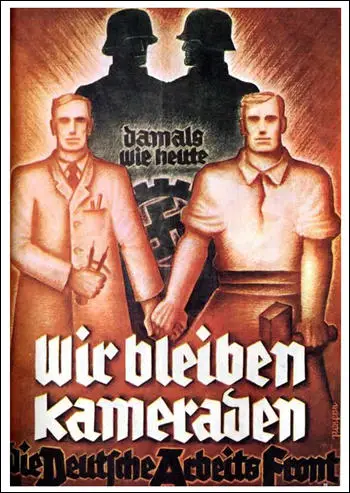
Three weeks later Hitler decreed a law bringing an end to collective bargaining and providing that henceforth "labour trustees", appointed by him, would "regulate labour contracts" and maintain "labour peace". Since the decisions of the trustees were to be legally binding, the law, in effect, outlawed strikes. Ley promised "to restore absolute leadership to the natural leader of a factory - that is, the employer... Only the employer can decide." (4)
Strikes in Nazi Germany
The German Labour Front was the only union organization allowed in the Third Reich and had over 20 million members. Ley appointed twelve state officials whose job it was to regulate wages, conditions of work and labour contracts in each of their respective districts, and to maintain peace between workers and employers. (5) The DAF was "rendered totally docile and workers no longer had any voice in management". (6)
The results of the elections to works councils suggest that the Labour Front representatives were not popular with the German workforce. As a result, no further elections were held after 1935. Some workers continued to resist fascism and in some sectors, such as metal and wood workers, railwaymen and seafarers maintained impressive illegal networks. (7)
The German Labour Front deprived the workers of any bargaining mechanism. The employer, with the support of the Labour Front, was able to decide on the amount that the workforce were paid. A wage freeze was decreed in 1933 and was enforced by the Labour Front during the period that the Nazis were in power, despite rising costs of living. "The Labour Front had become a gigantic state prison from which workers had no way out." (8)
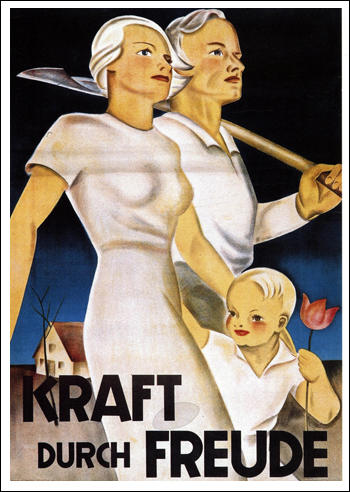
There was little resistance to the policies of the Labour Front. In June 1936, there was a seventeen-minute stoppage at Rüsselsheim Opel Works by 262 workers protesting against a wage cut brought about by raw-material shortages. The leaders were immediately arrested and over 40 of the men were blacklisted. (9) These tactics appeared to work. In 1928 a total of 20,339,000 days were lost to strikes. After the formation of the Labour Front, there were no recorded strikes in Nazi Germany.
In 1935 Robert Ley claimed that Germany was the first country in Europe to overcome the class struggle. (10) Although millions more had jobs, the share of all German workers in the national income fell from 56.9% in the depression year of 1932 to 53.6% in the boom year of 1938. At the same time income from capital and business rose from 17.4% of the national income for 26.6%.
William L. Shirer, the author of The Rise and Fall of Nazi Germany (1959) states: "All the propagandists in the Third Reich from Hitler on down were accustomed to rant in their public speeches against the bourgeois and the capitalist and proclaim their solidarity with the worker. But... the official statistics... revealed that the much maligned capitalists, not the workers, benefited most from Nazi policies." (11)
Corruption in the Labour Front
Robert Ley told the workers at the Siemens factory in Berlin: "We are all soldiers of labour, amongst whom some command and the others obey. Obedience and responsibility have to count amongst us again... We can't all be on the captain's bridge, because then there would be nobody to raise the sails and pull the ropes. No, we can't all do that, we've got to grasp the fact." (12)
One historian has claimed that the Labour Front was "the most corrupt of all the major institutions of the Third Reich." (13) In the early months of 1935, German newspapers reported over one hundred cases of misappropriation of funds involving officials of the Winter Relief, one of the schemes operated by the Labour Front. This led to so many rumours and speculations that the Labour Front decided to discontinue door-to-door collection of subscriptions in favour of deductions from wages. (14)
The Labour Front eventually had 25.3 million members. Each worker had 1.5 per cent of their wages deducted to cover costs. (15) By 1937 the annual income from membership fees to the Labour Front reached $160,000,000. How this money was spent remained a secret as Ley never published the accounts of the organization. It was believed that the institution was open to corruption. It was also claimed that Ley stole money that had been confiscated from former trade unions.
Ley was well rewarded for his role in the movement. As head of the Labour Front he was granted a salary of 4,000 Reichsmarks. His income was increased by 2,000 Reichsmarks as Reich Organization Leader of the Party, 700 Reichsmarks as a Reichstag deputy, and 400 Reichsmarks as a Prussian State Councillor. He also received royalties from books and pamphlets, which Labour Front officials were encouraged to buy in bulk for distribution to the members.
According to Richard Evans, the author of The Third Reich in Power (2005), "Ley... bought a whole series of grand villas in the most fashionable districts of Germany's towns and cities. The running costs, which in his villa in Berlin's Grunewald included a cook, two nannies, a chambermaid, a gardener and a housekeeper, were met by the Labour Front up to 1938, and even after that it paid all Ley's entertainment expenses. He was fond of expensive automobiles and gave two to his second wife as presents. Ley also had a railway carriage refitted for his personal use. He collected paintings and furniture for his houses." (16)
Volkswagen
While in prison in Adolf Hitler read a lot of books. Most of these dealt with German history and political philosophy. Later he was to describe his spell in prison as a "free education at the state's expense." One writer who influenced Hitler while in prison was Henry Ford's autobiography, My Life and Work (1922). It had been translated into German by Curt and Marguerite Thesing. It was one of a small collection of books that was found in his office after his death at Nazi headquarters. (17)
Hitler also read an article entitled the Motorization of Germany. It was during this time that Hitler developed the idea that he wanted to be responsible for Germany's Model T. According to Richard Evans, the author of The Third Reich in Power (2005), "by the early 1930s he was drawing rough sketches of a small family vehicle that would sell for less than a thousand Reichsmarks and so be within reach of the vast majority of the population". (18)
Soon after he gained power in 1933 Adolf Hitler announced that the "salvation of the German worker in an enormous and all-embracing attack on unemployment". (19) At the time six million people were registered as unemployed and three million more had disappeared from the employment statistics altogether, many of them women. In 1929 over 20 million had been in work, by the time Hitler took office, that number had fallen to 11.5 million. (20)
Hitler was aware that it was vital to reduce the number of people unemployed if he was to retain power. One of his first decisions was to order the construction of new highways under the direction of Fritz Todt. His goal was a network of 7,300 miles of four-lane highways. Todt calculated that building the motorways would provide employment for 600,000. By June 1935 there were over 125,000 men working on motorway construction. Hitler announced that this road building achievement was "an overture to peace" but was also undertaken to permit the rapid movement of troops in war. Hitler was especially interested in east-west highways in order to meet the demands of a two-front war. (21)
Hitler also wanted to fill these highways with German built motor cars. At that time, there was only one motor-car for every fifty persons (compared to one for every five in America). German people had to use a bicycle or public transportation to get about. Hitler approached leading figures in private industry and demanded they produced an automobile for around $396 (this was the kind of price being paid for cheap cars in America). They said it was impossible and so Hitler decided that they had to be produced by the state. (22)
In 1935 Adolf Hitler announced that the government had plans to produce a "People's Car" (Volkswagen). Hitler gave his drawings of his "beetle car" to Ferdinand Porsche, a man who had become famous for designing racing cars. However, Porsche's prototype design was not ready until the end of 1937. (23)
At Hitler's insistence, the car's production was funded by the German Labour Front as part of its Strength Through Joy scheme. Robert Ley, the movement's leader, was forced to provide 50 million marks in capital to produce the car. On 2nd August, 1938, Ley announced that: "A Volkswagen for every German - let that be our aim. That is what we want to achieve." He also gave details of how workers could obtain this new car. "I herewith proclaim the conditions under which every working person, can acquire an automobile. (i) Each German, without distinction of class, profession, or property can become the purchaser of a Volkswagen. (ii) The minimum weekly payment, insurance included, will be 5 marks. Regular payment of this amount will guarantee, after a period which is yet to be determined, the acquisition of a Volkswagen. The precise period will be determined upon the beginning of production." (24)
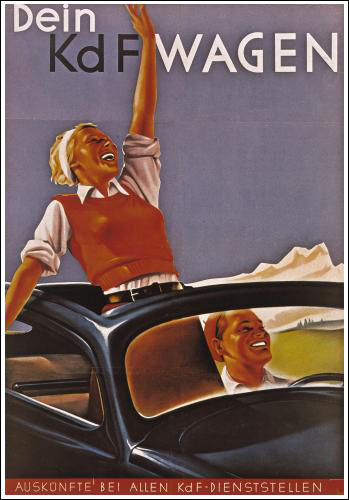
In contrast to universal hire-purchase practice, the scheme provided for delivery only after payment of the last installment. William L. Shirer, the author of The Rise and Fall of Nazi Germany (1959) wrote: "Dr Ley's ingenious plan was that the workers themselves should furnish the capital by means of what became known as a 'pay-before-you-get-it' installment plan - five marks a week, or if a worker thought he could afford it, ten or fifteen marks a week. When 750 marks had been paid in, the buyer received an order number entitling him to a car as it could be turned out." (25)
A huge advertising campaign was launched to persuade workers to put aside part of their wages to save up for one, with the slogan "a car for everyone". This was a great success and over 330,000 workers applied to buy a Volkswagen car. In 1938 a factory was built at Fallersleben to produce it. (26)
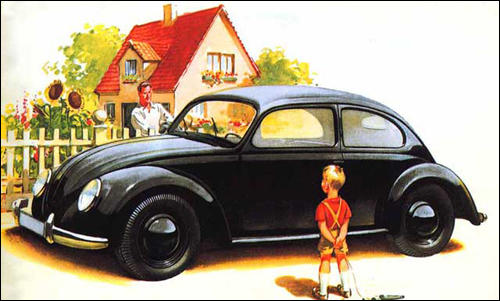
One German reported: "For a large number of Germans, the announcement of the People's Car is a great and happy surprise.... For a long time the car was a main topic of conversation in all sections of the population in Germany. All other pressing problems, whether of domestic or foreign policy, were pushed into the background for a while. The grey German everyday sank beneath notice under the impression of this music of the future. Wherever the test models of the new Strength-Through-Joy construction are seen in Germany, crowds gather around them. The politician who promises a car for everyone is the man of the masses if the masses believe his promises. And as far as the Strength-Through-Joy car is concerned, the German people do believe in Hitler's promises." (27)
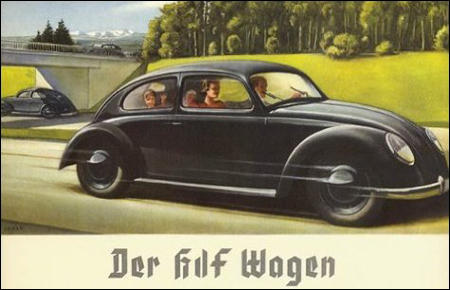
The first completed Volkswagen cars were exhibited at Munich and Vienna at the height of the Sudetenland Crisis in October 1938. (28) Another one was presented to Adolf Hitler at the International Motor Show in Berlin on 17th February 1939. Hitler gave it to his girlfriend Eva Braun as a birthday present. It became known as the "beetle" from the rounded shape Hitler gave it in his original design. (29)
Soon afterwards the Volkswagen factory at Fallersleben stopped making cars. Instead it turned to the manufacture of goods that would be needed by the military in the soon to start Second World War. Not a single car was produced for those 330,000 workers who had paid in their money to the German Labour Front. (30)
During the war the Volkswagen factory produced the Kübelwagen and the amphibious Schwimmwagen. Some of the labour force came from the Arbeitsdorf Camp. The company later admitted that it used 15,000 slaves during the war effort. German historians has estimated that 80% of Volkswagen's wartime workforce were supplied by concentration camps. (31)
Primary Sources
(1) William Shirer, was an American journalist working in Nazi Germany during the 1930s.
Despite his harassed life, the businessman made good profits. The businessman was also cheered by the way the workers had been put in their place under Hitler. There were no more unreasonable wage demands. Actually, wages were reduced a little despite a 25 per cent rise in the cost of living. And above all, there were no costly strikes. In fact, there were no strikes at all. The Law Regulating National Labour of January 20, 1934, known as the Charter of Labour, had put the worker in his place and raised the employer to his old position of absolute master - subject, of course, to interference by the all-powerful State.
(2) A member of the Labour Front was interviewed in 1938.
I hate the treatment of the Jews. I think it is a bad side of the movement and I will have nothing to do with it. I did not join the party to do that sort of thing. I joined the party because I thought and still think that Hitler did the greatest Christian work for twenty-five years. I saw seven million men rotting in the streets - often I was there too, and no one, not even the Churches, seemed to care that it was a wicked thing that children of God should be thus to rot. Then Hitler came and he took all those men off the streets and gave them health and security and work at least for the time being. Wasn't that a Christian act?
(3) The Manchester Guardian (5th January, 1939)
Three years ago Hitler ordered his leading motor engineers to design a small cheap car suitable for the use of members of the Labour Front.
The main part in the production of an exceptionally exacting design has been played by Herr Porsche, who has been responsible for some of the finest racing cars built in Germany. An enormous factory is being erected at utmost speed by thousands of workmen, and manufacture will begin this year, though even in the absence of further political crises it remains uncertain whether any large numbers of cars will be delivered within twelve months.
Considering that real wages are still low in Germany, a scheme for furnishing all members of the Labour Front with private motor-cars is definitely audacious, but if German press reports are trustworthy the plan is at least feasible, for it is stated that upwards of 200,000 cars have already been ordered. The finances of the totalitarian States continue to perplex economists, and no British authority has succeeded in solving the £ s. d. of this ambitious enterprise. It is, of course, obvious that if a dictator who periodically or continuously demands great sacrifices from his subjects desires to keep them contented he could hit no on more promising palliative than to provide a motor-car for every family, even if the scheme would exert a boomerang effect in time of war, when all fuel would be absorbed by the Air Force and a mechanised army.
(4) Fritz Thyssen, I Paid Hitler (1941)
In order to allay discontent, Hitler conceived of a new idea. Every German shall own his car. He asked industry to devise a popular car model to be built at such a low price that millions could buy it. The Volkswagen (People's Car) has been talked of for the past five years and has never been seen on the market. "These cars will be built for the new highways," said the party propagandists; "an entire family will be able to ride in one of them at 100 kilometers (60 miles) an hour." The party leaders say that the highways were built for the People's Car. But the People's Car is one of the most bizarre ideas the Nazis ever had. Germany is not the United states. Wages are low. Gasoline is expensive. German workers never dreamed of buying a car. They cannot afford the upkeep; to them it is a luxury.
Dr. Ley, the stammering drunkard who is the chief of the German Labor Front. He controls the four to five hundred million marks paid in every year by the German workers as dues to the Labor Front. I do not say that he puts all this money into his own pocket. But the figure has certainly turned his head.
He had an automobile factory built for the production of the People's Car. On this occasion he invented a brand new form of knavery. The future buyers of the People's Car were invited to buy it in advance, by making predelivery installments. This is the reverse of the credit installment system. The system shows genius. Ley pocketed about a hundred million marks when the war came because the People's Car factory now had to produce tanks and motorcycles for the army.
(5) Song sung by members of the Labour Front (c. 1936)
We demand from ourselves service to the end,
Even when no eyes are upon us. We know that we should love our Fatherland
More than our own life.
We vow that no one shall outdo us in loyalty,
That our life shall be one great labour-service for Germany.
So in this solemn hour we pray for blessing on the oath we take,
We thank thee, Führer, that we now have seen thee,
Do thou behold us as thine own creation?
May our hearts ever beat with thy heart's pulses,
Our lives find inspiration in thy love,
Behold us here! Thy Germany are we!
(Source 6) Days lost in strikes and unemployment in Germany Date Days lost in strikes (in thousands)
% of workers registered as unemployed
1927 6,144
8.8
1928 20,339
8.4
1929 4,251
13.1
1930 4,029
15.3
1931 1,890 23.3 1932 1,130 30.1 1933 96 26.3 1934 14.9 1935 11.6 1936 8.3 1937 4.6
(Source 7) Hermann Schmidt, a senior figure in the Labour Front, was interviewed in 1938 about life in the Nazi Party.
I hate the treatment of the Jews. I think it is a bad side of the movement and I will have nothing to do with it. I did not join the party to do that sort of thing. I joined the party because I thought and still think that Hitler did the greatest Christian work for twenty-five years. I saw seven million men rotting in the streets - often I was there too, and no one, not even the Churches, seemed to care that it was a wicked thing that children of God should be thus left to rot. .. Then Hitler came and he took all those men off the streets and gave them health and security and work at least for the time being. Wasn't that a Christian act? So it was because I am a Catholic that I said, "I will join the party and I will do all I can to help a movement which refuses to let the young manhood of this nation be wasted."
Student Activities
Hitler's Volkswagen (The People's Car) (Answer Commentary)
Adolf Hitler's Early Life (Answer Commentary)
The Assassination of Reinhard Heydrich (Answer Commentary)
Heinrich Himmler and the SS (Answer Commentary)
